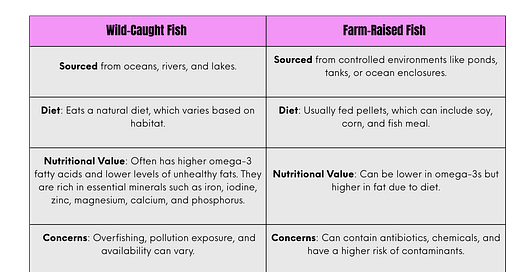Farm-Raised vs. Wild-Caught Fish: What’s the Catch?
Discover the healthiest choices, where to source them, and how to shop smarter for seafood!
When it comes to seafood, one of the biggest debates is farm-raised vs. wild-caught fish. While both have their benefits and drawbacks, making the right choice depends on factors like nutrition, sustainability, and sourcing. Let’s break it down simply, so you can make smarter, healthier choices without the guesswork, the Vango Wellness Way.
Farm-Raised vs. Wild-Caught: What’s the Difference?
💡 Vango Wellness Tip: Wild-caught is usually the better choice for nutrition, but there are some great farmed options if you know what to look for! Keep reading…
Which Fish Is Healthiest?
To maximize health benefits and minimize risks:
Best Wild-Caught Fish Choices:
✅ Salmon (Alaska) – Rich in omega-3s and low in contaminants.
✅ Sardines & Anchovies – High in nutrients, low in mercury.
✅ Mackerel (Atlantic, not King) – Omega-3 powerhouse, but avoid King Mackerel (high mercury).
✅ Halibut (Pacific) – Lean protein, mild flavor, but watch for sustainability concerns.
Best Farm-Raised Fish Choices (When Wild Isn’t Available):
✅ Rainbow Trout (U.S. farmed) – Sustainable and lower in contaminants.
✅ Barramundi – High in omega-3s and responsibly farmed in the U.S.
✅ Arctic Char – Similar to salmon but typically farmed in cleaner environments.
But, not all seafood is created equal. Best Seafood Certifications to Look For
Many fish can be contaminated with mercury, antibiotics, or harmful farming practices, making it crucial to choose safe and sustainable options.
And here’s the kicker—the “organic” label on seafood means nothing (seriously). Unlike land-based farming, fish can't be raised with the same organic standards, so labels like “organic salmon” are often misleading. The USDA doesn’t regulate organic seafood, so you need better ways to evaluate quality.
The answer? Look for trusted third-party certifications that verify sustainability, environmental impact, and safety —and know where to source your fish.
✅ Top-Tier Certifications (Best Quality & Sustainability):
MSC (Marine Stewardship Council) – The gold standard for wild-caught seafood, ensuring sustainable fishing.
ASC (Aquaculture Stewardship Council) – Ensures responsible, low-impact fish farming practices.
Best Aquaculture Practices (BAP) – 4-Star Rated – The highest level for farmed fish, covering environmental responsibility and food safety.
🔹 Second-Best Certifications (Still Good, But Less Strict):
BAP (1-3 Stars) – Covers farmed seafood but with fewer sustainability measures.
GlobalG.A.P. – Ensures responsible farming but is less transparent than ASC.
Whole Foods Market Responsibly Farmed Seal – A private label with good standards but not third-party certified.
💡 Vango Wellness Tip: If a fish isn’t certified, check where it comes from (more on that next).
Beyond Certifications: Smart Sourcing for Sustainable Seafood
While certifications like MSC and ASC are valuable, smart sourcing is your next best tool for healthy and responsible seafood choices. Look beyond the label and consider where your fish comes from.
Prioritize Regions with Strong Regulations:
Seek out seafood from countries and regions known for their robust fisheries management. These include:
Iceland & Norway: Leaders in quota systems and sustainable practices.
New Zealand: Renowned for their comprehensive Quota Management System.
United States (especially Alaska): With strict regulations and a focus on preventing overfishing.
Australia: Emphasizing ecosystem-based management.
Supermarket Sourcing Strategies:
Check Country of Origin: Labels should clearly state where the fish was caught or farmed. Favor those regions listed above.
Ask Questions: Don't hesitate to inquire about fishing methods and sustainability practices.
Look for Freshness: Clear eyes, firm flesh, and a mild ocean scent are key.
Consider Frozen: High-quality frozen fish can be a sustainable choice.
Why Vango Wellness cares: Choosing seafood from well-regulated regions supports healthy fish populations and minimizes environmental impact. Even without certifications, you can make informed decisions by understanding where your seafood originates.
When selecting seafood, consider the following:
Check the Country of Origin:
Look for labels that clearly state where the fish was caught or farmed. Prioritize seafood from regions with strong environmental regulations.
Avoid seafood with vague or unclear origin information.
Inspect the Packaging:
For packaged fish, carefully examine the label for any certifications (MSC, ASC, BAP).
Check the "best by" or "use by" dates to ensure freshness.
Look for packaging that indicates how the fish was processed (e.g., "previously frozen," "fresh").
Visit the Seafood Counter:
Don't hesitate to ask the seafood counter staff about the source of the fish.
Inquire about the fishing methods used and any sustainability practices.
Ask if they can provide information about the fish's journey from catch to counter.
Freshness Indicators:
Smell: Fresh fish should have a mild, ocean-like scent. Avoid fish with a strong, "fishy" odor.
Appearance: Look for fish with clear, bright eyes and firm, glossy flesh.
Texture: The flesh should spring back when lightly pressed. Avoid fish with soft or mushy spots.
Frozen Considerations:
Frozen fish can be a good option, especially if it was frozen shortly after being caught.
Check the packaging for information about how the fish was frozen and any added ingredients.
Avoid packages with ice crystals, as this is a sign of refreezing, which can reduce quality.
Avoid Pre-Prepared Seafood When Possible:
Pre-seasoned or pre-prepared seafood can mask the fish's quality and may contain added ingredients that you want to avoid.
It is always best to buy the fish in its most natural state
By being mindful of these factors, you can enjoy a diverse range of seafood options while supporting sustainable practices.
Need guidance navigating the supermarket aisles?
Vango Wellness Supermarket Run PDF is designed to help you make informed choices effortlessly.
Let's make health uncomplicated, one meal at a time.
Join the Vango Wellness Community!
💌 Subscribe to our newsletter for more wellness tips.
📲 Follow us on Instagram for daily motivation.
🎯 Book a FREE coaching consultation to start your personalized wellness journey.
Your healthiest, most vibrant life starts with the choices you make today!





